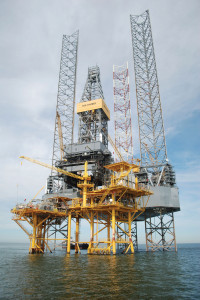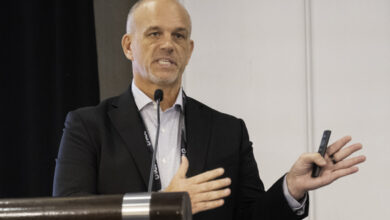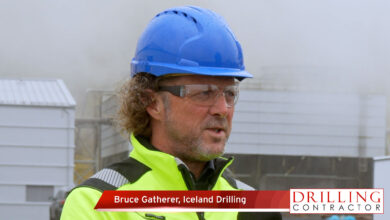Risk-based approach to competency places focus on rig floor, well control

Contractors expanding safety management systems to formalize stronger process safety components
By Katherine Scott, associate editor
Thomas Burke is chief operating officer of Rowan Companies and 2013 IADC vice president – offshore division.
For today’s drilling contractors, what are the industry’s highest-priority issues?
For the majority of drilling contractors, the highest priority continues to be safety of personnel performing drilling operations. Contractors are moving from a purely personal safety approach to formalizing stronger process safety systems.
Competency of personnel is also a critical issue. Given recent industry events, ongoing retirements of experienced personnel and the number of new assets under construction, ensuring personnel competency is a high-priority issue.
Operators have been talking a lot more about process safety since Macondo. What are you hearing from clients in terms of process safety requirements?
Process safety requirements of our operator customers vary widely. Some major operators are highly focused on the issue, with clear definitions and systems in place. These larger operators also expect their vendors, including drilling contractors, to have similar systems in place. For smaller operators, process safety is much less formal, and there are few official requirements on their contractors.
What has Rowan been doing to reduce its incident rate?
At Rowan, our two highest priorities are safety and integrity. Our CEO and our entire management team speak to our employees on every occasion about these two interwoven values. We reiterate that it is every employee’s responsibility to ensure that each job is conducted safely – including stopping the job if necessary to protect our employees or others at the work site.
Our company’s safety incident rate has declined dramatically in the last 10 years. While our strong safety program and energized professionals supporting line management has been a factor in our success, the main reason for fewer incidents has been the focus and expectations set by our managers, supervisors and employees to be injury-free.
Tactically, we have had several initiatives, including strong reporting and investigation, and have trained our employees in stop work authority and having effective safety conversations.
When we have an incident, near-miss or dropped object, our employees report the incident, and we investigate the circumstances. We make sure we understand what happened and why, determine the best way to prevent future similar incidents, and then we educate the rest of our fleet to share the lesson learned. This may seem fairly elementary, but with our rigs working in so many different regions, it is not trivial to actually make it happen.
Stop work authority is just what it sounds like – we ensure all of our employees and third parties on our rigs and in our facilities understand that they have the authority and the obligation to stop the job whenever they believe it is unsafe or something is going wrong. As an example, in the North Sea last year, one of our roustabouts assigned to assist in a helicopter arrival procedure noticed that the helicopter fuselage was damaged. He called a “timeout for safety.” The helicopter was shut down, and an aircraft mechanic arrived to fix the issue.
By stopping the job, the roustabout may have saved lives, and he received much praise for speaking up. Rowan’s workforce is empowered “to do the right thing” to ensure the safety of our operations.
We have also spent time and resources teaching our employees how to have effective safety conversations. We believe we achieve better safety results when employees and third parties have conversations about safety, rather than just completing and filing a form. We have not met our goal of zero injuries, but our safety performance is better than it has ever been.
After safety, what other critical issues is the industry facing?
In offshore drilling, we are experiencing a rapid growth cycle, which followed years of relative stagnation. Maintaining crew competence to meet our company needs and our customers’ expectations in an era of tremendous industry growth is a challenge, particularly in a post-Macondo environment.

Our efforts are focused on retaining, recruiting and hiring the right people and ensuring all of our employees are competent to complete the jobs required. The growth in other parts of the energy industry, such as land drilling and completions, will mean even tougher competition for talent.
While most large drilling contractors have their own competency programs, IADC is working on this issue from an industry perspective. The association’s Knowledge, Skills and Abilities (KSAs) project is going to be a tremendous help industrywide.
What do you feel needs the most updating in current competency programs?
At Rowan, we think about competency from a risk-based perspective. We do need to ensure competence across all positions and tasks; however, we have prioritized our competency efforts and training on those employees handling tasks on the rig where there is “the highest price of failure.” Clearly these “high-risk” positions and tasks are concentrated around the rig floor and with an emphasis on well control. We believe this is a strong approach and certainly something for others in the industry to consider.
Should workers be measured in IADC competency as well as company competency?
Each large drilling contractor should design and use its own competency program that is specific to its values, assets, policies and procedures. At Rowan, we have our own competency program that was developed in the North Sea and is being pushed across the company. However, IADC is not just serving the larger drilling contractors; it is also serving a lot of smaller companies that simply cannot afford to have a custom competency program.
Nonproductive time can be a critical issue. What can the industry do to work with suppliers to improve equipment reliability?
We’re spending a lot of time with suppliers trying to help solve equipment issues and increase uptime. Often suppliers don’t have a full appreciation for the failure modes of their equipment or how the equipment is actually used in field operations. The industry needs to do a better job of sharing the causes of failures with suppliers, getting suppliers to understand the root causes and then collaborate on solutions.
We have determined that we can achieve better results if we are more involved in monitoring the manufacturing process of our vendors – by participating in the build and the commissioning process of equipment, we can ensure our vendors have a better understanding of how we plan to use the equipment and can solve failure issues before they occur.
Along those same lines, shipyards are building the rigs, but they’re not the ones operating them. Should drilling contractors be doing more to monitor the shipbuilding process?
The dynamics of rig construction have changed over the last decade. Historically, a drilling contractor would contract a shipyard to build a vessel and would also furnish the drilling equipment and other key systems. Previously, the drilling contractor would choose the equipment vendors and be responsible for the integration and the commissioning of critical systems. Now shipyards perform these tasks. This shift has changed the dynamics of the OEM and shipyard markets dramatically, with the manufacturers selling directly to the shipyards rather than the drilling contractors.
At Rowan, we have four ultra-deepwater drillships under construction in Korea. Over the past six years, we have also built and delivered 11 high-specification jackups. We have found that on-site supervision and quality control is critical, as well as agreeing to a strong commissioning plan with the shipyard. We have a program called Ready-To-Drill, which focuses Rowan and the shipyard on ensuring the rig or ship is ready for drilling operations as soon as it leaves the shipyard.
Our increased staffing and attention during the construction process has resulted in increased budget control, more predictable delivery timing and a better end product. We are an active partner with the shipyard and review lessons learned to ensure we continuously improve our processes. When we have a problem, we believe it is vital to have the shipyard accept and acknowledge the issues after the rig is delivered. By continuing to involve the shipyard, they have a better understanding of critical issues and how to address them in future construction projects.
Looking at the challenges of deepwater drilling, what equipment improvements can be made?

Here are two examples of what we have done at Rowan:
First, we’ve spent about $12 million on each of our drillships to enhance riser gas-handling capabilities. We believe this provides a step-change improvement in managing the hazards of expanding gas in the drilling riser.
Second, with multiple software systems on each vessel from different vendors, we are using ABS’ integrated software quality management notation (ISQM) to drive consistency and exert control. ISQM is a risk-based software development and maintenance process built on internationally recognized standards. The ISQM process verifies the software installation on the facility and then monitors for consistency when there are software updates or a change in hardware. We believe this software assurance will benefit Rowan and its customers greatly.
A lot of people are talking about moving toward more automation. What is your take on this issue?
A lot of equipment around the rig floor on modern rigs is automated, or at least mechanized. While increased automation is beneficial as it removes personnel from dangerous operations, our experience has been that increased automation can lead to increased downtime or nonproductive time for technical issues or failures. The cause of these issues and failures is likely a lack of detail design and testing from the equipment manufacturer before equipment is installed on the rig. Failure mode analysis or hardware testing is key to really understand what’s going to happen when the equipment goes out to the rig.
You were recently reelected as the vice president of IADC’s offshore division for 2013. How does industry benefit from sharing between companies, even if they’re competitors?
Drilling contractors are competing aggressively; we never share any competitive data or information. However, I believe IADC and its committees are healthy for the industry, our customers and suppliers. Executives, managers and people in this industry are open about issues, particularly regarding safety. IADC safety reports, for example, are an excellent resource for sharing details of serious wellsite incidents that benefit the industry as a whole.
How has the dynamic between operators and contractors evolved since Macondo?
Some operators want drilling contractors more involved in their planning process, though many key decisions are made well before rigs are selected and contracted. Others are highly interested in contractors’ feedback as how to improve the efficiency of their operations. It varies with the customer, but across the board, operators are soliciting more input. Closer involvement has provided contractors with a much deeper understanding of operator challenges and what success looks like to our customers. Ultimately, the more drilling contractors are involved in operator processes, the more likely we are to jointly succeed.




